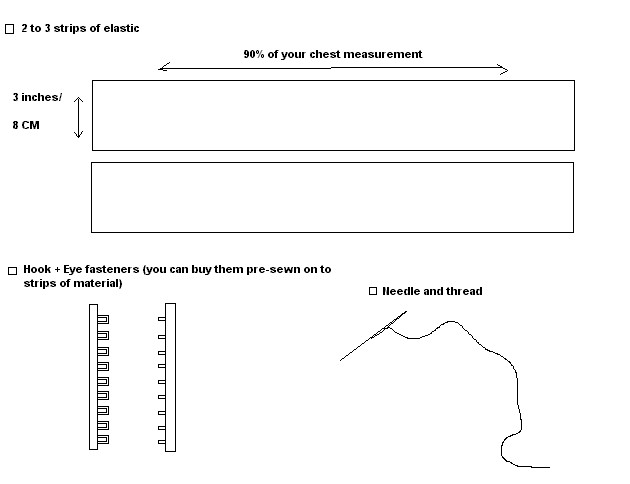
HOMEMADE BINDER INSTRUCTIONS
Below are instructions on how to make a binder out of strips of elastic. This is both a cheap and easy method - the binder will cost approximately £5 in total and the materials used for it can easily be purchased at haberdasheries, markets, or department stores such as John Lewis. It is therefore suitable for those who do not have the money or credit cards necessary to order binders online from shops such as Underworks. You only need minimal sewing skills to make this binder (as long as you are capable of holding a needle and doing basic tacking you should be fine.)
In order to make the binder you will need the following materials;

GETTING THE RIGHT MEASUREMENTS:
Each strip of elastic should be fairly wide; 3 to 4 inches (approximately 8-10 CM) is ideal. To determine the necessary length for the elastic, you must measure your chest. To do this, find a tape measure and measure your chest at the largest point. The elastic needed to be about 90% of this measurement, although it can be tighter if necessary.
For instance, if your chest measures 32 inches at the widest point, to work out the measurement necessary, you would need to do the following;
32 / 100 x 90 = 28.8 inches.
The same calculation is necessary for CM;
81 / 100 x 90 = 72 CM
So in that case, the length of elastic would need to be about 29 inches, or 72 CM. It may be worth buying slightly more than you need, as you can always cut some off to adjust it whereas if you find it too tight, you would have to purchase more elastic.
Your chest size determines how many strips you need - generally a small to medium chest will only need 2, whilst a larger chest will need 3.
HOOKS AND EYES:
Hook and eye fasteners are available loose
or pre-sewn on to a strip, and should be available in the same
place you purchase your elastic. It is highly recommended you
purchase the pre-sewn variety, as the loose ones take an extremly
long time to sew on to material. The length of the strip of
material they are sewn on to should be about the same as the
width of both (or all 3) of your strips of elastic. So for
instance, if you are using 2 strips of elastic, each 3 inches
wide, you should buy 6 inches of hooks and 6 inches of eyes, etc.
MAKING THE BINDER
Overlap the strips of elastic like planks in a garden shed. They should overlap by a few centimetres. Sew them together every few inches to stop them coming apart, like so;

You should now have, essentially, one thicker strip of elastic. At this point it may be worth testing the binder by wrapping it around your chest and fastening it with safety pins to ensure you have the correct length of elastic. You may need to cut off some if it is not tight enough to bind correctly, but ensure that it is loose enough for you to be able to comfortably breathe.
Once you are comfortable with the length, you need to sew on the hooks and eyes. Sew the hooks on one end, and the eyes on the other. This needs to be done fairly securely as the hook and eye fastening is what holds the binder together to keep it as tight as possible.

The binder should now wrap around your chest comfortably, whilst making you sufficiently flat. Adjust as necessary. It should stay up by itself provided it is tight enough. However, you can optionally use leftover elastic or material of any kind to make shoulder straps in order to ensure it stays up, but this is down to personal preference/necessity. You may decide to make more than one binder - try making one for looser binding and a tighter one for when you need to be as flat as possible.
Be responsible when binding - optimum binding time is 8 hours. Do not bind for more than 12 hours. Do not sleep in your binder. Take breaks if possible. Remember that binding regularly can break down the breast tissue and change the shape of your breasts and elasticity of the skin. This change is irreversible, so make it worth it.